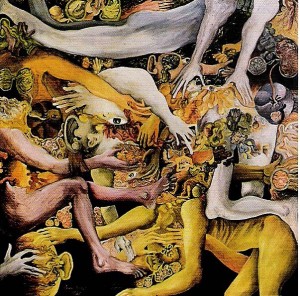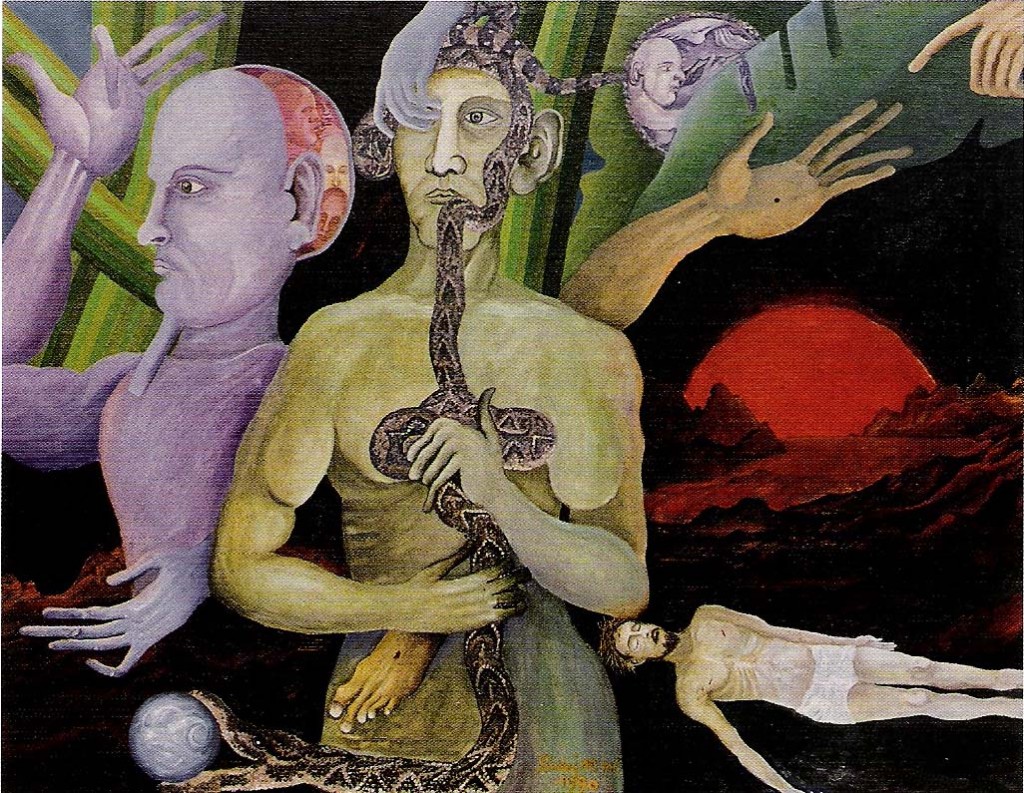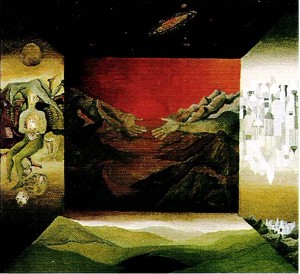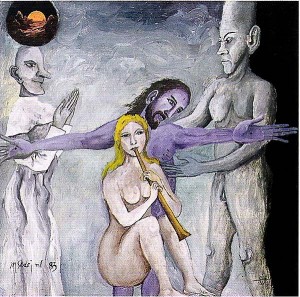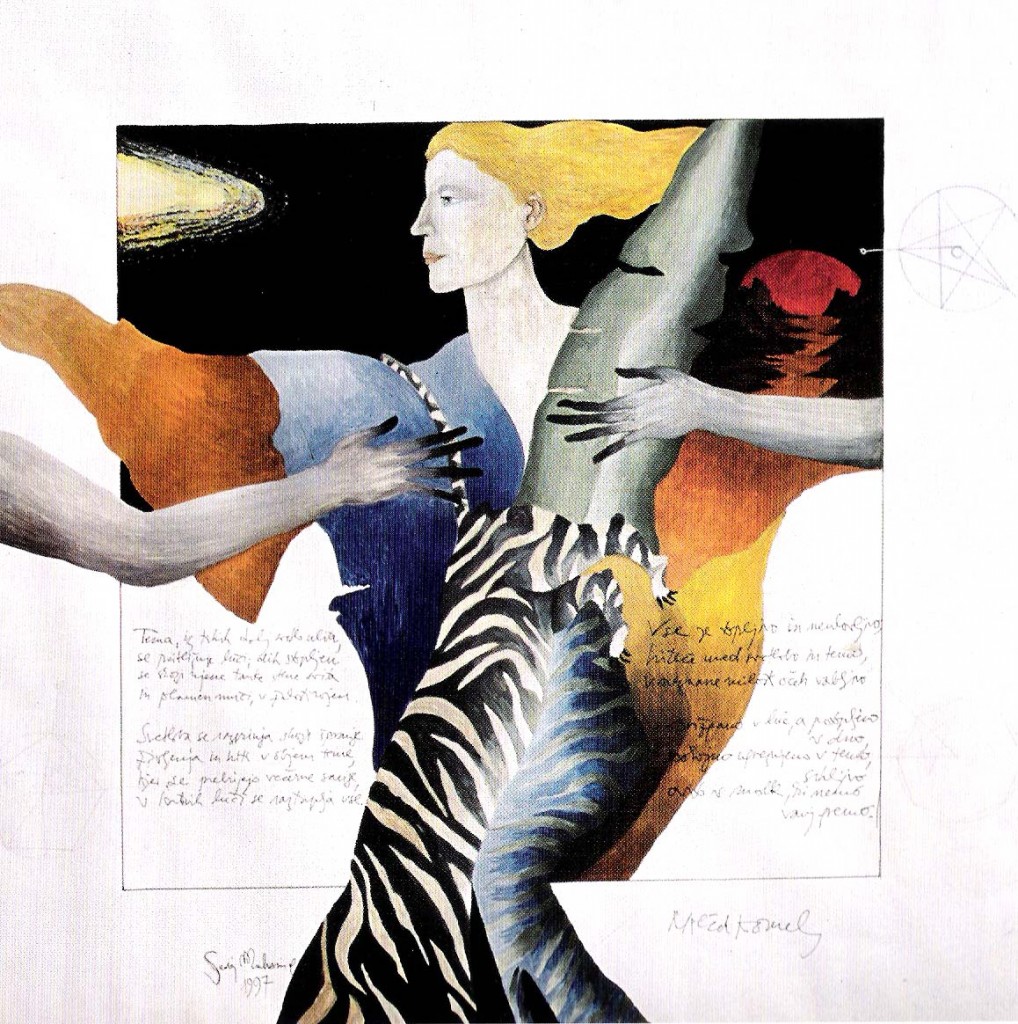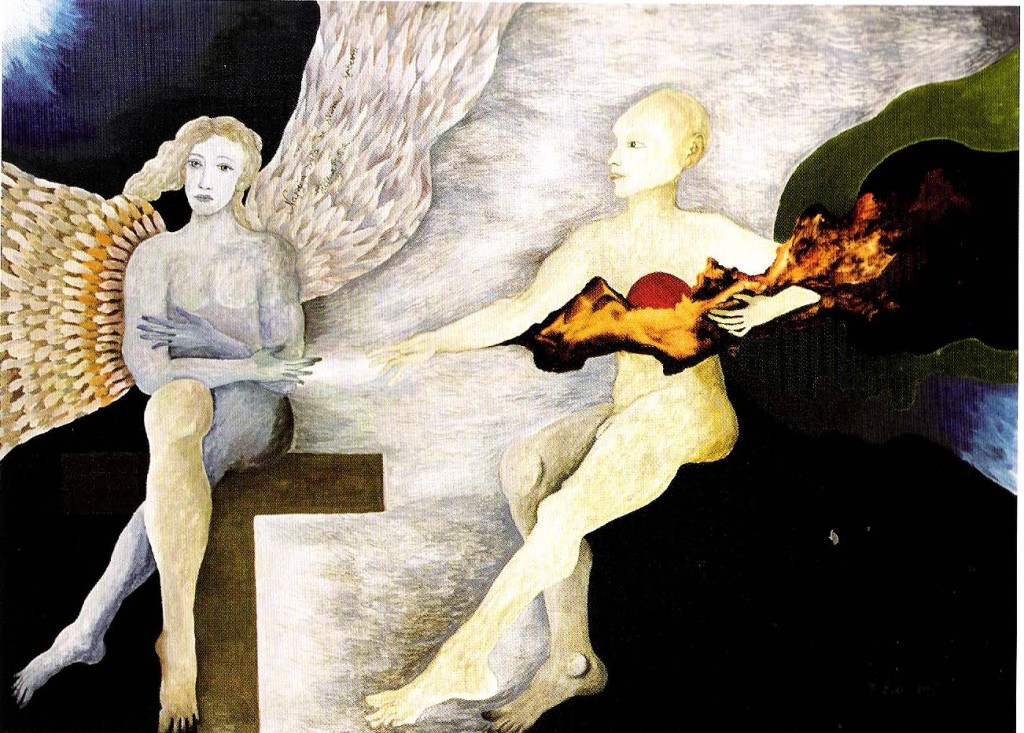IV. FACE OF THE SOUL – Death and revelation
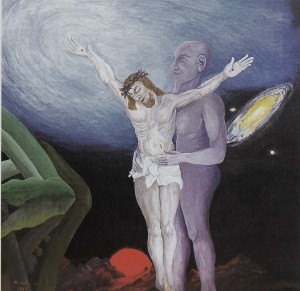
Maksim Sedej ml.: Kristus v vesolju
Olje na platnu, 120×120 cm, 1993
Death is the fate of each individual and revelation is the biblical foretelling of the end of the world and of time. Already at the onset of his awareness, man had to confront his own destiny, the inevitable end of secular life and the cataclysm which could exterminate the entire human race. Yet he accepted this as agiven and, rather than resist it, sought to find an acceptable response to it, to find comfort and to postpone, if possible, the horror of death and cataclysm. First, theologians and, in later days, anthropologists began to reveal the phenomenon or mystery of the immortal soul which had already been recognized and conceptualized by our most distant ancestors: in the myth s of fiery snakes in the sky, in floods, in the sulfuric fiery red-hot explosions that would exterminate mankind (or at least most of it). These were the first mythological or mystical forecasts of the end of the world and depicted an end which would be the consequence of (super)natural forces and thus distinct from the revelation of the apostle John. The apocalypse according to John is the final act of the Christian religion on the planet Earth and represents both the final end and the redemption of mankind. In today’s world, this is one of the possible fates that mankind mayencounter.
When exploring the destiny of man, we must first ask ourselves the question: Who is man? The history of mankind tells both of man’s greatness and his depths. This history can not be adequateIy explained by the instincts presented in either Darwin’s or Freud’s theories. Moreover, it would be impossible throughout the history of mankind to draw a strict border separating good from evi! on the human path towards eternity just as it would be impossible to separate the Medici family from the great artists created under its patronage.
There ore only two spiritual forces that distinguish between good and evil in Western civilization: the Christian gospel and the conscience of the individual who takes responsibility for his own actions. These two dimensions are related, interdependent and form the basis upon which all good and evi! must be judged.
The birth of the conscience mind can be found in the earliest incarnation of our distant ancestors in the instant they wrenched themselves away from the harmony of Nature and pursued their own path.
The beginning of Christianity is even easier to pinpoint. It dates back to the time when Moses, in Egypt, discovered faith in one God and later when he saw God on his way to Canaan with the chosen people. Yet what occurred there was actually precisely the opposite: God saw Moses, called on him and revealed his Commandments to him.
When asking the question – who is man? – it is impossible to isolate the individual and treat him separately from the community. Man is a social being, connected with the family and the community to which he belongs. Hermits, gurus and other solitary figures appear only in highlydeveloped civilizations. In the first communities of man, the individual who was ostracized or expelled from the group was condemned to a horrible death. I lived in a time when death was no longer part of the natural cycle but fell under human control.
Man succumbed to evil and sowed death ruthlessly. During those years, I mourned the loss of countless friends and acquaintances but there was one death which would shatter me more than all the others and it shattered me even before it actually occurred. Every afternoon my father used to take an hour or two for himself. His iIIness was drying him up more and more. Every day he sat at a table and looked at the color reproductions of the painters he most admired. One day when I visited him, he was sitting on a chair, holding his head in his hands. Areproduction of Van Gogh’s, Pain, lay before him on the table. He empathized so intensely with the other artist’s pain that he didn’t even notice that I had come in the room. He looked in my direction but didn’t see me. I recognized in his eyes a despair and emptiness that was rising from a seemingly bottomless loneliness. Long ago when I sat near his chair or stood by the table as his model, he often had long conversations with himself, not having the slightest idea that I would remember them. He would talk about the awful emptying of his essence after the completion of a cycle of paintings or an exhibition. And how slowly, slowly, he got back the energy he had poured into his work. These depressions following creative bursts were something quite normal. It took him quite some time to gather fresh energy and put it once again into his painting. Sometimes though he filled the emptiness created by the System, the emptiness which changed his whole notion of the condition of the world, with alcohol. *
The best therapy for artists is work and I often tried, along with Taras Kermauner, to persuade my father to work, to make new paintings. We brought him canvases. He painted his own death which such indifterence that I already knew it, already felt it. For him, there was no longer any dividing line between life and death. Father became astral, only seeming to live in this world, just walking through it. He painted on the canvases that we had brought to him. He concluded his cycle containing the image of a guitarist playing a guitar which had neither strings nor the hole to make an echo. Thus his life came to an end just as it had begun. The cycle ended. An exhibition was held in Trbovlje with the graphics depicting God that my father and the poet, Ludvik Marzel, had created at the beginning of their artistic careers. Singers sang him farewell at the exhibition and he died three days later. My father was sitting in a pub on the last day of his life just as he had in his painting ln the Pub. He was drinking wine and cognac with my mother. He died at the table.
France Prešeren knew this state of mind and, in one of his poems, he asked that death not hesitate too long. I al so once experienced a sort of Death; it was there beside me and then it disappeared. I experienced it as a condition that even today I cannot rationally explain. Our child had died because of an incompatible RH factor. Anka lay in a coma in the intensive care unit at the hospital. In those days, in the City, no visits to the hospital were permitted during the week. I wasn’t even allowed to enter the hospital doors. I sat for hours and days against a wall outside the hospital. Leaving the building, one nurse or another might ofter me a word of comfort before hurrying home.
I didn’t see any doctors; they came to the hospital through another entrance and I hadn’t the strength to try to find it. I simply sat hunched against the wall. One day around noon the hospital door opened. The head physician approached me very slowly, looked at me for alittie while and then said: “I’m sorry. Your wife has died. We did everything we could.”
ln that moment, the endlessness of the Universe open ed up inside of me and I shouted into that limitless space my disagreement with death and my plea to undo this thing. Of course, I didn’t articulate this thought, didn’t say it aloud. My message to the Universe was formulated in a sort of a code and in that code was not only my love but, without knowing it at that moment, the seed of everything I intended to do in the future. Later on I would be able to decipher the code, to understand a bit here and a bit there, but only when I was in the greatest distress. But never again would I feel such a close connection to the Universe. Perhaps I approached it in some of my paintings. But in that instant, I must have fallen into a sort of a trance because the head physician merely shrugged and went back through the door.
I don’t know how many minutes or hours elapsed while I sat there but some time later he appeared in front of me again. He tapped me on my shoulder and said: “Your wife is much better now.
With alittie luck, we’lI be able to save her.” When evening fell, theyallowed me into the hospital to watch Anka through alittie window in the door. Her eyes were wide open and she was smiling. She didn’t see me but she knew I wasn’t far from her.
I had asimilar experience, though on a totally different level, when my mother died. She lay in the hospital seriously iiI. It was a beautiful Saturday, the day before Easter. Anka and I planned to take flowers to my father’s grave and then to pay my mother a visit in the hospital. Something came over me, a pressure in my chest. Instead of going to the graveyard, we hurried to the hospital and there we caught the last moment of her life. She was in a deep coma but she was waiting for us. I took her hand in mine. She squeezed my hand and died. I knew that this was more than a last goodbye, that it was al so arnessage which committed me and Anka to fulfil her hidden wishes and hopes for us. There are ways of communication in the universe which greatly surpass the technological and scientific contemporariness of existence.
ln the same way that the poet’s death had been cruel and unreasonable, Franci’s death was al most invisible. Invisible in the literal sense of the word. Despite the fact that even in life he was almost invisible, Franci did receive from time to time a sum mons from the authorities who did their work slowly but inexorably. Over the course of a few months, a number of summons for settling civil obligations accumulated. Franci received no other mail. As usual, several pigeons perched on the windowsiII of his room in the first floor of an old town building so it didn’t occur to anybody that something could be wrong. But Franci was on welfare of sorts and he hadn’t come to pick up his money for months and finally the clerks decided to break into his home. The little room was empty. The only thing odd about it was the slightly stale smelI. The bed was untouched. An ancient-Iooking blanket lay upon it, slightly wrinkled and bunched up. There were a few dried pieces of cheese on the blanket and dried rat excrement on the floor – not on the bed. The clerks were ready to leave when one of them, the more pedantic of the two, removed the blanket from the bed whereupon the situation suddenly became crystal clear. Franci himself lay beneath that slightly wrinkled coverlet, totally desiccated, like a spread-out old newspaper. Invisible. In our scientific virtual reality, it is essential to defend the human race, to know the essence of its poetry to which the Song of Songs commits us. Love and death are the ultimate fulfillment of a life of awareness.
Perhaps the foretelling of the apocalypse is not as dreadful as it may seem at first. Or perhaps it will be even more inconceivable than we might imagine from John’s Revelations and from the modern scientific truths about the universe.
The Soviet generals were quite confident of the enormous progress science had made, so confident that they thought that, because of such prog ress , Stalin would live forever. Thank God that their science-fiction wishes were off by at least a couple decades. But cloned man is now al most a reality. Dictators will be able to multiply themselves into endless lives. This capability promises a totally different attitude towards death than is currently prevalent among creative people. Despite their faith, or rather because of it, people understand what their mission is, understand that they will somehow remain in the conscience of the nation or even of the world, participate in Creation even after their death. They do not need to be aware of this but certainly the fulfillment of mankind’s mission in this world is fundamentally linked to life and death.
The desire to live forever in the body has been present in man’s conscious mind for a very long time. The Egyptian mummies may have been the first to experience a sort of human reincarnation in the living body but it is certain that genetics and cloning will accomplish something similar soon. Even experiments concerning the human conscience itself do not seem so distant any more. Today in their laboratories, scientists strive to achieve the basic conditions for the creation of living matter. Perhaps not too far in the future, they will manage to (virtually) emulate the conditions to recreate not only the life but the conscience (or soul) of a pharaoh. Did the ancient Egyptians have an inkling of such a future? Perhaps they were already absolutely certain of it.
A contemporary artist can only dream of such bold ventures yet sooner or later cybernetics will fulfill even this dream. Geneticists and cybernetics are the artists of the future.
When I think about the future of this world, I begin to feel like an inhabitant of Altamira who, filled with the miracle of nature, crawled into the depths of a subterranean cave. In that eternal darkness, iIIuminated only by the light of burning twigs, he drew on the stone wall the images of the miraculous nature he held within his heart. As if he wanted to preserve and protect it for ever. This, at least, is how I understand the heritage and vision of the people of Altamira. Will we and our offspring be able to cherish and protect such a heritage?
It is precisely in this way that the two cycles of paintings which Istarted painting in the seven ties – Nothing New about Nature and ApocaJypse – are interconnected. They both stem from my previous work and knowledge about art but they differ in their depiction of the four faces of the soul.
All the threads of my creative work, from its very beginnings, led in the same direction and finally merged in these two cycles. Each individual painting carries within itself the truth and spontaneity that I felt at the moment I created it. These last cycles of paintings are, however, compIeted by the poetic contribution of the blossoming people for whom I’ve never stopped searching.
CONCLUSION
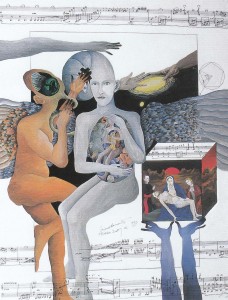
Maksim Sedej ml. in Primož Ramovš: Štirje obrazi duše, 1977
olje na papirju 100×127 cm,
komponist Primož Ramovš je svojo glasbeno kompozicijo lastnoročno vkopmponiral v sliko
The primeval sound that permeates our universe is present in every instant of the universe’s existence regardless of how fast it is expanding or curving or contracting. On the human level, this sound is a kind of poetics which can never be altered or automated or robotized because poetics is not made of material substance. It is spiritual. It is the sound, the word and the color of the universal home where we all belong.
Contemporary art and even the more technological variety of this art follows in the footsteps of science in search of the “united field of art”, a sort of prehistory or origin of all art. But this is sameness. And sameness is not in man ‘s nature because man is an important part of the universe, the very universe which allowed him to perceive Creation of which he himself is a part. Man is both a spiritual and a material being and the inclination to harmonize these two dimensions differs in each individual. The greater the harmony, the more free man is. And here I speak of real freedom, freedom which does not limit the freedom of others.
Nowadays a certain dissatisfaction with reason dominates the spiritual domain. In the emerging relationship between technological and scientific interventions into the arts, poetics remains the only guarantee of and hope for the uniqueness and intimacy of each individual. Poetics sets limits on both the equality and the uniformity of people.
The difference between crude totalitarian uniformity through the exercise of ideological constructs and the contemporary technological revolution is in fact only in the methods – which in the latter is disguised as freedom and equality. Both tend toward the creation of the global uniformity of people, not towards the global equality of people. Poetics exists in the nature of all people, in the same way that reason does. The domination of one over the other spells catastrophe.
But perhaps this potential catastrophe is nothing more than the leading idea of contemporary barbarism. Perhaps it is similar to the notion which destroyed the mentality and self-sufficiency of the antique world, transformed it with fresh blood and ideas, ultimately enabled the creation of a new harmony between the spiritual and the material.
Scientific truth will always be subordinate to the details and changes that complement, supplement and mirror each other. New scientific discoveries in the material world are concerned with these details and changes.
Poetics always arises from feelings about the Condition of the world, about both the spiritual and the material world. But art is by definition connected to individuality and can only be expressed by individuals. For this reason, it is also unique and unrepeatable. An individual can identify with his own poetics but he can not artistically imitate the poetics of another artist in such a way that would artistically express the Condition of the world. Dušan Pirjevec was among the first in Slovenia to glean an inkling about this truth of poetics. Though an atheist, he recognized God in this truth.
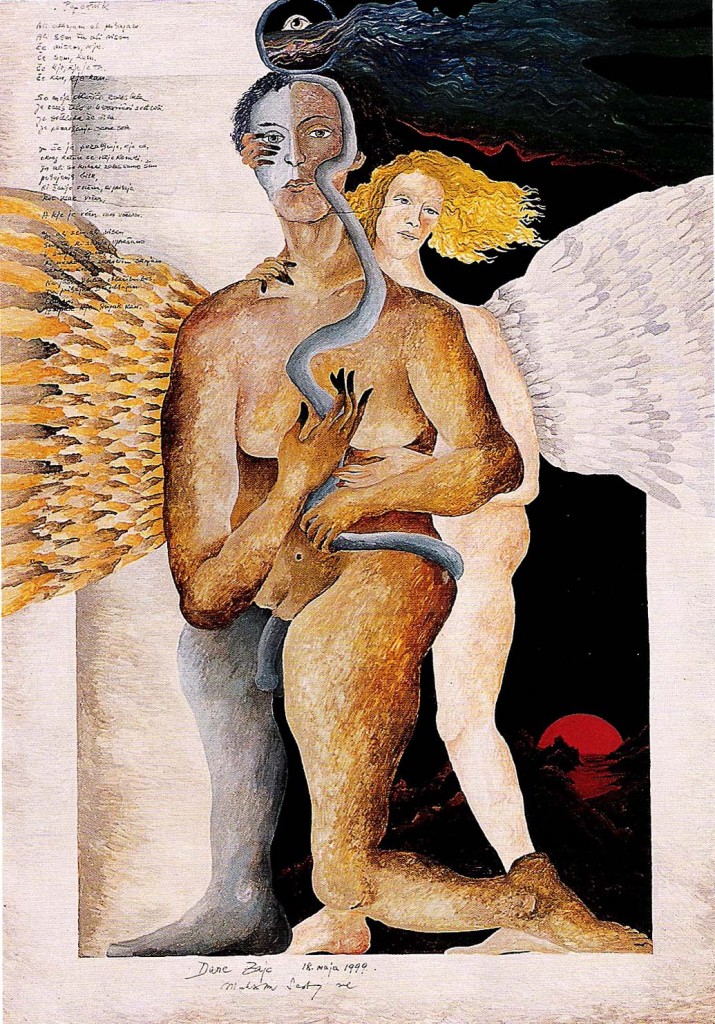
Maksim Sedej yr., Four Faces of the Soul, Traveler, poems of Dane Zajc
Oil on paperboard, 143x100cm, 1994
The cycle Four Faces of the Soul was created to express my personal understanding of the inaccessibility of the infinite, the inaccessibility of the divine. It represents my attempt to synthesize the poetic ideas and dreams which have obsessed and overwhelmed me throughout my whole life. I invited some other unique artists to help me create this cycle and these extraordinary people helped me to create – to co-create – a clear picture of the Condition of our world.
This book was published by the author because it was the only way for him to prese nt the work as an integral whole in terms of its textual contents and artistic reproductions. In 1998, I sent the introduction to this book to a number of institutions and individuals but received only one response – and that one by phone. Itwas rather unusual: the editorial board requested that I reduce the introduction to twelve pages and eliminate a single name from the text.
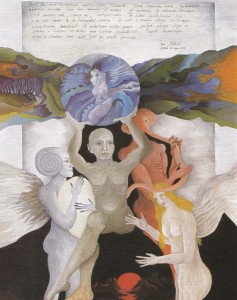
Maksim Sedej ml. in Ivan Urbančič: Štirje obrazi duše
Olje na kartonu, 101×150 cm, 2000,
filozof Ivan Urbančič je v sliko lastnoročno vnesel svoje misli in občutke, ki sliko dopolnjujejo
Ljubljana, 24th April, 1999
MAKSIM SEDEJ YR

Maksim Sedej yr., Four Faces of the Soul, with philosopher Taras Kermavner
Oil on paper, 100×128 cm, 1997


